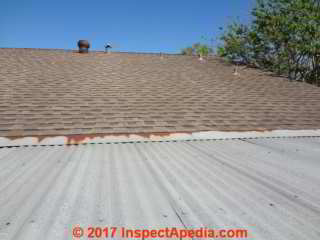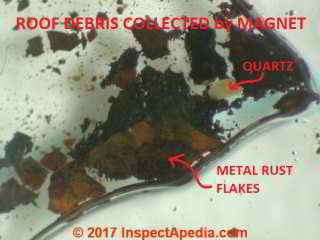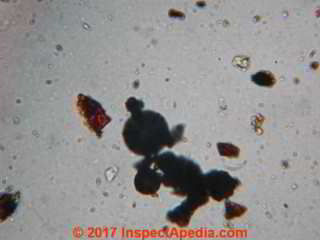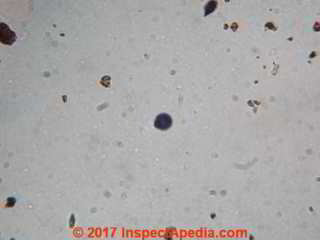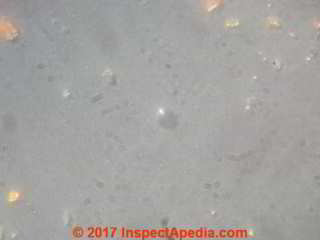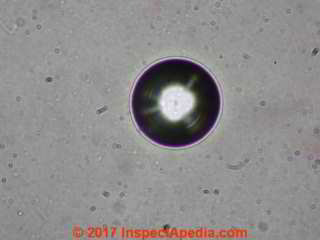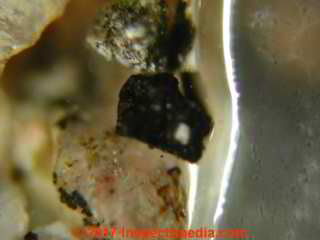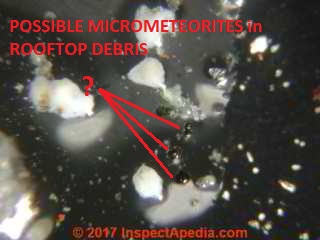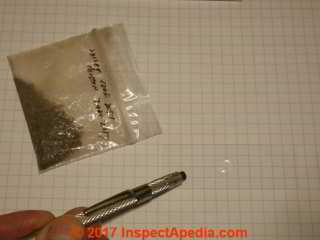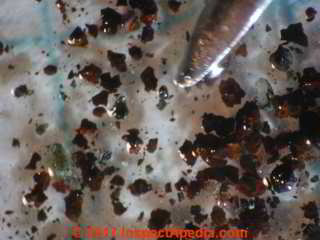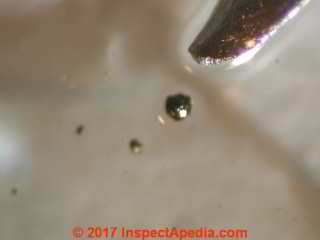 Micrometeorites in Roof Dust/Debris
Micrometeorites in Roof Dust/Debris
Find micro-meteorites in roof gutters?
- POST a QUESTION or COMMENT about micrometeorites found on roof surfaces
Micrometeorites from rooftops:
This article describes the collection and examination of debris and granules from an asphalt shingle roof in Houston TX. We conclude that it's not that easy to tease out a possible micrometeorite from a large volume of roof dust and debris, even when using a magnet.
Page top photo, a small hard sphere isolated from roof debris, attracted to a magnet, possibly a micrometeorite.
InspectAPedia tolerates no conflicts of interest. We have no relationship with advertisers, products, or services discussed at this website.
- Daniel Friedman, Publisher/Editor/Author - See WHO ARE WE?
Are the Magnetic Particles in Debris in Roof Gutters Micrometeorites?
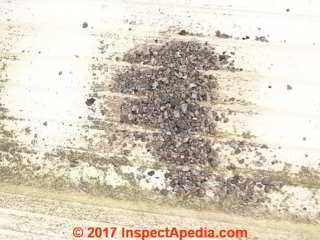 Question: magnet picked up roof shingle granules in the gutters: are these micro meteorites?
Question: magnet picked up roof shingle granules in the gutters: are these micro meteorites?
I ran a magnet through a little pile of shingle granules in the gutters, and found metal particles and flakes. Are there metal flakes, or any metal at all in the granule protective layer of asphalt shingles? Must know before I lecture on meteorites. S.R. Houston TX 2017 03/05
I passed a magnet through a pile of granules in the gutter and found many flakes of metal. Are metal flakes part of the "mineral" coating? If not, I suspect meteorite particles. S.R. by private email 2017/11/02
[Click to enlarge any image]
Photo: granular debris in a plastic roof gutter of a home in Houston Texas.
Reply: probably not if there is nearby rusting iron or steel or if the particles are large
Is this the same dust we discussed back in April? I recall noting that the metals found in roof shingle granules are most-often copper, zinc, or sometimes aluminum in coatings, included for algae resistance, reflectivity, or appearance.
I'm not, however entirely surprised that you'd find magnetic or iron based particles. Magnetic particles in roof debris or dust could be from inclusions used to give an asphalt shingle a desired color or they might be from rusting metal such as that I see in one of your photos.
 However there are certainly going to be exceptions to what's common, and some magnetic metals including iron oxides might be used for color purposes, as I'll cite:
However there are certainly going to be exceptions to what's common, and some magnetic metals including iron oxides might be used for color purposes, as I'll cite:
Photo: mineral-granule coated asphalt roof shingles on the Houston TX home.
Metallic Iron Oxides Used in Roof Colorings
Sources of both metallic iron oxides and other metals used in asphalt roof shingles or roll roofing that are coated with mineral granules include metal-flakes used to provide a desired color to the shingles (Hansen 1983 & Kiik 2002) and also metallic oxides used to increase the solar reflectance of roof surfaces (Levinson 2007).
Non-magnetic particles washing off of roofs and into gutters, onto the ground and into nearby waterways include minerals or metals used to improve the roof's resistance to algae growth and staining. The metallic component of asphalt roof shingle granules might contain copper or zinc - those are not magnetic minerals.
Examination of particles washing off of roofs, both mineral and others, is not new.
VanMetre and Mahler (2003) looked at the composition of particles and wash-off from rooftops and the contribution of these materials to contamination in urban streams.
Other Sources of Magnetic Particles in Roof Runoff: Metallic Rust Particles
Iron particles that may be attracted to a magnet could come from other roof sources such as metal chimney caps, flues, or plumbing vent pipes, even galvanized metal flashing- depending on the age and type of on-roof components at a building.
Photo: rusty metal roof flashing can be a source of iron and iron oxide that one might collect by magnet in roof granular or dust debris.
To separate metallic particles of rust from iron-rich micrometeorites you will need to use a high power magnifier or a stereo microscope for a first pass.
Properties of MicroMeteorite Particles vs Other Spherical Particulates
Genge et al (2017) writing in Geology, described micrometeorites as small, principally spherical particles that have been collected in small numbers from rooftops.
Backscattered electron microscopy images of the particles studied by those authors show that the particles are principally spherical, but never perfect spheres.
That helps to rapidly distinguish potential micrometeorites from very spherical particles seen under the light microscope and more-often identified as paint droplets or perhaps certain basidiomycetes or as certain pollen grains that may occur at similar sizes.
The Genge article is helpful in identifying micrometeorites as they note that
The identification of particles as micrometeorites is achieved on the basis of their compositions, mineralogies, and textures.
All particles are silicate-dominated (S type) cosmic spherules with subspherical shapes that form by melting during atmospheric entry and consist of quench crystals of magnesian olivine, relict crystals of forsterite, and iron-bearing olivine within glass. - Genge (2017)
The authors explain that because they are super-heated while passing through earth's atmosphere, those particles that are not incinerated are generally spherical in shape and are comprised of a range of minerals that they identified, including iron.
As I will cite below, an individual particle of cosmic dust that might be found on rooftops, while often magnetic, is also very small, in the 100u range up to 300-440u. (Buddhue 1950 & Handy 1953).
As a point of reference, individual ragweed pollen grains are about a tenth of that size. Human hair ranges in thickness from about 20u to 180u. Most human hair is around 25-100u in diameter.
Without a high power microscope you might have difficulty seeing such individual particles.
The presence of such dust particles on the earth's surface has been discussed in the U.S. since at least the 1950's, and such particles have been collected from deep sea sediment where it is possible to obtain samples that are not contaminated or confused by contemporary airborne particulates in the industrialized (and globally contaminated) world.
In March 2017 in the New York Times William Broad reported on flecks of extraterrestrial dust that might be collected from rooftops (Curiously not all of such tiny particles simply burn up while passing through the atmosphere, but they are heated to a very high temperature, probably explaining their spherical form when collected on earth).
That article is of interest and pertinent to your question since the dust particles were collected from gutter sediment. However nothing in that report mixes roof granules with cosmic dust. (Though I imagine that small dust particles would be mixed in with roof mineral granules and might even adhere to them.
I'd be surprised, however if the magnetic properties of the dust were strong enough to permit a magnet to lift up entire roof mineral granule particles).
I have some of your gutter debris sent to me back in April. I'm back in the U.S. and will take a look at that in our lab as soon as I am able, and I'll report to you on what I can see. I will look, particularly, for particles similar to those discussed in the Broad (2017).
It may be significant, however that the Geology article has not been cited by other scientific researchers - at least not in any online search I could perform as of November 2017. So further thought and reading and investigation are probably appropriate.
Reader Follow-up: roof dust micrometeorite experiment as school project
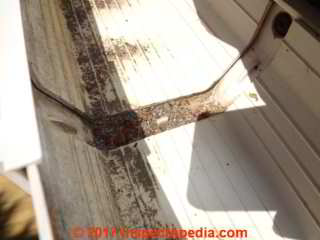 I conducted a little experiment after writing you last. I placed a strong magnet just above the shingles on my roof... no attraction. Then I scraped some of the granules off and tried the magnet... nothing.
I conducted a little experiment after writing you last. I placed a strong magnet just above the shingles on my roof... no attraction. Then I scraped some of the granules off and tried the magnet... nothing.
But when I ran the magnet through some granules that had collected in the gutter, I get many, many small pieces of ferrous metal. This confirms something I read about the whole Earth being constantly bombarded by meteorites.
Most of them burn up in the atmosphere, but some survive as flakes and particles and land on rooftops (and on everything else, too). Imagine that -- being able to collect space material off your roof.
I've collected about an ounce of flakes and I'm going to give a lecture at my astronomy club on this subject on Friday. It will make an interesting school science project for kids. - S.R. 2017/03/05
Reply:
Also, if you like, send me a dust sample in a clean ziplok freezer bag and when I return to the U.S. later this spring I'll examine it in our forensic lab.
Reader Follow-up:
I'll send you my samples and be as sterile as possible. I hope it survives in your in-box for that long. Please write upon your return.
Reply:
As we're not so worried about biological particles, the sample should be ok in transit or storage.
Photos of your roof, closeup of shingles, and closer photo of the granule debris would be good to have too.
If you have access to a 100x or greater microscope you might take a look at the dust yourself as well. I work at 620 to 1200x and use polarized light, microchemistry and a few other tricks to take a closer look.
Reader follow-up:
Attached are the photos you requested. The first one is of a space between two lengths of gutter that didn't come together, leaving a convenient "trap" for particles.
The second is of places where the dips of the corrugated roof empty into the gutter.
I'm mailing a sampling of the particles I collected with a magnet. I'm anxious to see what your analysis comes up with. - S.R. 2017/04/04
Reply:
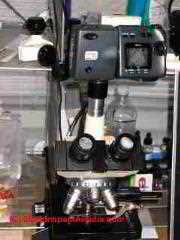 Better to have a roof or gutter debris & dust sample collected physically without resorting to a magnet so that we have a representative sample not a magnetically-selected sample.
Better to have a roof or gutter debris & dust sample collected physically without resorting to a magnet so that we have a representative sample not a magnetically-selected sample.
We can always separate magnetic particles in the lab.
I also note in your photos that roof runoff crosses what looks like galvanized metal flashing down onto a corrugated metal roof; it'd be no surprise to find some rust and other metallic fragments in roof runoff from such a roof.
Reader follow-up:
I just now mailed a second sampling of roof particles through which no magnet has been passed.
As for the flashing, I would imagine an analysis would distinguish rust from meteoric material but most-likely rust flakes and particles are visually obvious and will be obviously different from a particle that was superheated, melted, and became an ovoid particle passing through the atmosphere.
Later, when time permits, perhaps you or other readers will assist by collecting particles from other roofs with no obvious sources of extensive rusting metal.
And in answer to your query, yes a microscopist can usually recognize rust in the microscope, even without chemical testing. Rust fragments are, well, rust-colored, and tend to be irregular flakes and pitted irregular surfaces.
Meteoric material is more smooth and tends to be spherule-shaped though not likely perfect spheres.
Lab Photos of Roof Debris Screened for Evidence of Spherical Micrometeorites
Above: Under the stereo microscope at low magnification metallic iron rust flakes were the dominant particle in the gutter debris sample collected using a magnet.
In the photo you'll also see a small quartz fragment, possibly from a mineral granule roof coating or from road dust and debris. You will also see very small sub-micron particulate debris, all irregularly shaped at this magnification.
[Click to enlarge any image]
The largest rust flake in its long-dimension was about 2mm.
Above: magnified at about 720x we examine the smaller particles mixed in with the roof debris collected from the Houston TX home's roof gutter in 2017.
The smallest particles in this photo are about 1u in diameter. The two spherical particles are most-likely paint droplets. The sample is illuminated here by transmitted light.
Above: we selected this tiny spherical particle (about 90u) for closer examination, but it's so round that I already suspect it's either a paint droplet or a bubble.
Above is the same spherical object, illuminated by top-lighting under the forensic microscope (POLAM) in our lab. The clear/white colour suggests that this is simply a bubble in the mounting fluid.
Above is the same spherical rooftop "object" magnified to about 1200x in oil immersion. It's a bubble, not a particle.
There might be micrometeorites in the debris sample from this Houston Texas roof but our first pass through the particles collected by a magnet didn't produce one.
Microscopic Photos of Granular Roof Particles Collected Without a Magnet
Our photo above shows a first pass look at particles collected from the Houston roof gutter - clearly we're looking mostly at (mostly white) mineral particles - rocks or mineral granules.
Our second photo above shows some of these particles at higher magnification. These are not micrometeorites.
Next we focused our attention on smaller particles in this roof debris sample. In our top-lit microscope photo below we see four silver-colored spherical objects. Could those be micrometeorites?
Possibly, but it's necessary to take a more-careful look. In many mounting fluids including Triacetin and simple immersion oil air bubbles can be quite small and under some light can look silver. Side lighting and top lighting can usually sort out this question.
Taking a Second Careful Look Through Roof Debris Particles: the search for micrometeorites
We repeated this experiment using immersion oil to secure our particles: in that mix were indeed some perfect silver spheres of tiny air bubbles.
Below I'm using a small magnet to transfer magnetic particles from a collection of roof debris particles onto a microscope slide whereon I've placed a drop of immersion oil.
When working with a stereo microscope we're not using a cover slip, but the immersion oil keeps me from accidentally blowing off or losing the particles en route to the microscope.
The blue grid lines in our earlier photos give a relative scale: each full square = 0.25" or about 6.35mm or 6350u (microns). So if we have a particle that's about 1/20th of a grid square in dimension we're looking at a 300u particle.
In the roof debris "micrometeorite search" sample above and enlarged below also saw large spheres of iron rust (shown below) as well as mineral granules, quartz, and fragments of asphalt.
Above, a comparatively large rough sphere of rusty metallic debris, probably from rusting metal flashing seen in roof photos earlier in this article. This is not a micrometeorite.
To screen roof dust and debris for micrometeorites that can be identified by simple light microscopy and without chemical analysis we looked for the following:
- Spheroid objects that are fairly smooth
- Spheroids that are not perfect spheres
- Particles in the 100-500 u size range
- Particles that probably landed on the roof surface recently, following meteor activity
- Particles that landed on the roof before rain has washed off the roof and its gutter system
Really? This procedure will not identify all types of micrometeorites. That's because not all micrometeorites melt during their passage through the atmosphere, and thus some micrometeorites may appear to be irregular in shape and un-melted, coarse grained, crystalline and may vary in color: metallic, black, crystalline,(Genge 1997) (Maurette 1991) (Kurat 1994)
Using a small probe (shown at page top) to push aside the very large roof mineral granules we looked with care through the remaining debris and found this sphere, a hard metallic spherical object about in the photo below. We pushed this particle off more-or-less by itself for a closer look. This particle is about 100u in diameter.
The spheroid particle shown above was wet and held in place by immersion oil and has other still-smaller debris fragments adhered to it. This might be a micrometeorite. But take care, Anselmo (2007) warns that most small spherical particles that you might collect from outdoor dust and debris are not micrometeorites.
These results suggest that it is not a trivial exercise to tease particles that may be micrometeorites out of a hand full of debris collected from a roof or roof gutter. Indeed, Larsen and Genge of Project Stardust in Oslo reported that
In order to separate the MMs from other types of terrestrial spherules, Project Stardust conducted ~1000 field searches for particles (~50-5,000µm in size) in ~50 countries worldwide over 7 years. (Larsen 2016).
Research on Microscopy & Analysis of Roof Granules, Dust, Debris for Particles of Interest
- Anselmo, Attilio. "Observation of false spherical micrometeorites." arXiv preprint arXiv:0708.4276 (2007).
Abstract:
The work describes the results of the study of the spherical particles that can be found in the environment and that were often considered as micrometeorites. The results have demonstrated that in the most of cases these spherical particles are the results of the human activity. - Boonyatumanond, Ruchaya, Michio Murakami, Gullaya Wattayakorn, Ayako Togo, and Hideshige Takada. "Sources of polycyclic aromatic hydrocarbons (PAHs) in street dust in a tropical Asian mega-city, Bangkok, Thailand." Science of the Total Environment 384, no. 1 (2007): 420-432.
- Broad, William J., "Flecks of Extraterrestrial Dust, All Over the Roof", The New York Times, 2017/03/10, available at https://www.nytimes.com/2017/03/10/science/space-dust-on-earth.html
- Buddhue, J.D., 1950, Meteoritic dust: University of New Mexico Publications in Meteoritics 2: Albuquerque, University of New Mexico Press, 102 p.
- Chang, Mingteh, and Christopher M. Crowley. "Preliminary observations on water quality of storm runoff from four selected residential roofs." JAWRA Journal of the American Water Resources Association 29, no. 5 (1993): 777-783.
- Davis, Jeffrey J., and Brian L. Gulson. "Ceiling (attic) dust: a “museum” of contamination and potential hazard." Environmental research 99, no. 2 (2005): 177-194.
Abstract excerpt: Ceiling or attic dusts provide an indirect measure of air pollution integrated over varying time periods. - Dodd, Robert T. Meteorites: A petrologic-chemical synthesis. CUP Archive, 1981.
- Engrand, Cecile, and Michel Maurette. "Carbonaceous micrometeorites from Antarctica." Meteoritics & Planetary Science 33, no. 4 (1998): 565-580.
Abstract:
Abstract— Over 100 000 large interplanetary dust particles in the 50–500 μm size range have been recovered in clean conditions from ∼600 tons of Antarctic melt ice water as both unmelted and partially melted/dehydrated micrometeorites and cosmic spherules. Flux measurements in both the Greenland and Antarctica ice sheets indicate that the micrometeorites deliver to the Earth's surface [approximately] 2000× more extraterrestrial material than brought by meteorites.
Mineralogical and chemical studies of Antarctic micrometeorites indicate that they are only related to the relatively rare CM and CR carbonaceous chondrite groups, being mostly chondritic carbonaceous objects composed of highly unequilibrated assemblages of anhydrous and hydrous minerals.
However, there are also marked differences between these two families of solar system objects, including higher C/O ratios and a very marked depletion of chondrules in micrometeorite matter; hence, they are “chondrites-without-chondrules.”
Thus, the parent meteoroids of micrometeorites represent a dominant and new population of solar system objects, probably formed in the outer solar system and delivered to the inner solar system by the most appropriate vehicles, comets. One of the major purposes of this paper is to discuss applications of micrometeorite studies that have been previously presented to exobiologists but deal with the synthesis of prebiotic molecules on the early Earth, and more recently, with the early history of the solar system. - Genge, M. J., J. Larsen, M. Van Ginneken, and M. D. Suttle. "AN URBAN COLLECTION OF MODERN-DAY LARGE MICROMETEORITES: Evidence for variations in the extraterrestrial dust flux through the Quaternary." [PDF] Geology 45, no. 2 (2017): 119-122. Retrieved 2017/11/13, original source: https://spiral.imperial.ac.uk/bitstream/10044/1/42484/9/Geology-2016-Genge-G38352.1.pdf
Also available at https://pubs.geoscienceworld.org/geology/article/45/2/119/195213/an-urban-collection-of-modern-day-large
Abstract:
We report the discovery of significant numbers (500) of large micrometeorites (>100 μm) from rooftops in urban areas. The identification of particles as micrometeorites is achieved on the basis of their compositions, mineralogies, and textures.
All particles are silicate-dominated (S type) cosmic spherules with subspherical shapes that form by melting during atmospheric entry and consist of quench crystals of magnesian olivine, relict crystals of forsterite, and iron-bearing olivine within glass. Four particles also contain Ni-rich metal-sulfide beads.
Bulk compositions are chondritic apart from depletions in the volatile, moderately volatile, and siderophile elements, as observed in micrometeorites from other sources. The reported particles are likely to have fallen on Earth in the past 6 yr and thus represent the youngest large micrometeorites collected to date.
The relative abundance ratio of barred olivine to cryptocrystalline spherule types in the urban particles of 1.45 is shown to be higher than a Quaternary average of about 0.9, suggesting variations in the extraterrestrial dust flux over the past 800 k.y.
Changes in the entry velocities of dust caused by quasi-periodic gravitational perturbation during transport to Earth are suggested to be responsible. Variations in cosmic spherule abundance within the geologic column are thus unavoidable and can be a consequence of dust transport as well as major dust production events.
Conclusions:
The discovery of 48 cosmic spherules, collected primarily from roof gutters in Norway, 122 www.gsapubs.org | Volume 45 | Number 2 | GEOLOGY is reported from a collection of 500 spherules identified as micrometeorites.
All particles are S-type cosmic spherules and have mineralogies, textures, and compositions identical to those of cosmic spherules collected from Antarctica and deep-sea sediments, including porphyritic, barred, and cryptocrystalline types and particles that retain Fe-Ni metal and sulfide beads.
The discovery demonstrates that, contrary to current belief, micrometeorites can be collected from urban environments. The abundance of recovered spherules is consistent with estimates of the global spherule flux to Earth of ~6 t d–1.
The relative abundance of spherule types within the modern urban spherules and ca. A.D. 800–1500 spherules from the South Pole Water Well compared with collections of spherules that accumulated over longer periods provides the first evidence for short-term variations in the extraterrestrial dust flux through the Quaternary - Genge, M. J., C. Engrand, M. Gounelle, and S. Taylor. "The classification of micrometeorites." Meteoritics & Planetary Science 43, no. 3 (2008): 497-515.
Abstract:
Due to their small size, the mineralogical and chemical properties of micrometeorites (MMs) are not representative of their parent bodies on the centimeter to meter scales that are used to define parent body groups through the petrological study of meteorites.
Identifying which groups of MM are derived from the same type of parent body is problematic and requires particles to be rigorously grouped on the basis of mineralogical, textural, and chemical properties that reflect the fundamental genetic differences between meteorite parent bodies, albeit with minimal bias towards preconceived genetic models. Specifically, the interpretation of MMs requires a rigorous and meaningful classification scheme.
At present the classification of MMs is, however, at best ambiguous. A unified petrological-chemical classification scheme is proposed in the current study and is based on observations of several thousand MMs collected from Antarctic ice. - Genge, Matthew J., Monica M. Grady, and Robert Hutchison. "The textures and compositions of fine-grained Antarctic micrometeorites: Implications for comparisons with meteorites." Geochimica et Cosmochimica Acta 61, no. 23 (1997): 5149-5162.
Abstract:
Micrometeorites recovered from the Earth's surface constitute the most abundant interplanetary dust now falling to Earth. We studied eighty-nine fine-grained Antarctic micrometeorites (fg-AMMs) to evaluate their state of alteration and to identify the nature of their precursor materials.
Fine-grained AMMs are divided into melted and unmelted groups and subdivided on the basis of textures related to atmospheric entry heating. The textures of melted particles reflect crystallisation after entry heating and those of unmelted AMMs broadly resemble Cl, CM, and CR chondrite matrix. The matrix compositions of the fg-AMMs closely resemble those of CM2 chondrites.
Matrices provide a more reliable comparison to meteorites than bulk compositions because components such as chondrules and CAIs are not present in representative proportions within individual AMMs.
Divergences from CM-like matrix compositions are generally minor and probably arose during entry heating by the dissociation of volatile-bearing phases at subsolidus temperatures and evaporation and loss of immiscible metallic liquids at higher temperatures. Depletions in Ni and Mg relative to CM matrix are tentatively attributed to terrestrial weathering. No conclusive evidence for contamination during atmospheric residence was observed.
Contrary to theory, textural evidence suggests that bow shocks and high thermal gradients existed during deceleration of micrometeoroids in the atmosphere. - Handy, R.L., and Zimmerman, D.T., 1953, On the curious resemblance between fly ash and meteoric dust: Iowa Academy of Science Journal , v. 60, p. 373–379.
- Hansa, M., and I. Zacharov. "Collections of the meteoric dust during Perseids." Bulletin of the Astronomical Institutes of Czechoslovakia 9 (1958): 236.
- Hansen, David R. "Roofing shingle." U.S. Patent 4,405,680, issued September 20, 1983.
- Kiik, Matti, Michael Bryson, and Margie Beerer. "Metal flake-surfaced roofing materials." U.S. Patent Application 10/274,717, filed October 21, 2002.
The present invention relates to roofing materials for roofs, sidewalls and other exterior surfaces exposed to the weather such as, but not limited to, asphaltic and non-asphaltic roofing materials, wherein metal flakes cover up to 100% of the weathering surface of the roofing materials.
The metal flakes may be applied to the surface in striations or bands separated by conventional roofing granules or may be blended with conventional roofing granules.
The metal flakes may have antimicrobial potential and may provide resistance to microbial growth to roofing materials when dispersed in or applied thereto.
The present invention also relates to methods of making the roofing materials. - Kurat, Gero, Christian Koeberl, Thomas Presper, Franz Brandstätter, and Michel Maurette. "Petrology and geochemistry of Antarctic micrometeorites." Geochimica et Cosmochimica Acta 58, no. 18 (1994): 3879-3904.
Abstract Excerpts:
The petrology and geochemistry of twentythree chondritic dust particles with masses of 1–47 μg (sizes 100–400 μm) were recovered from blue ice near Cap Prudhomme, Antarctica, and studied by INAA, ASEM, EMPA, and optical microscopy.
Sample selection criteria were irregular shape and (for a subsample) black color, with the aim of studying as many unmelted micrometeorites (MMs) as possible. Of thirteen unmelted MMs, six were phyllosilicate-dominated MMs, and seven were coarsegrained crystalline MMs consisting mainly of olivine and pyroxene. The remaining ten particles were largely melted and consisted of a foamy melt with variable amounts of relic phases (scoriaceous MMs). Thus, of the black particles selected, an astonishing portion, 40% (by number), consisted of largely unmelted MMs.
Although unmelted, most phyllosilicate MMs have been thermally metamorphosed to a degree that most of the phyllosilicates were destroyed, but not melted. The original preterrestrial mineralogy is occasionally preserved and consists of serpentine-like phyllosilicates with variable amounts of cronstedtite, tochilinite-like oxides, olivine, and pyroxene.
The crystalline MMs consist of olivine, low-Ca pyroxene, tochilinite-like oxides, and occasional Ni-poor metal. Relics in scoriaceous MMs consist of the same phases. Mineral compositions and the coexistence of phyllosilicates with anhydrous phases are typical of CM and CR-type carbonaceous chondrites. However, the olivine/pyroxene ratio (~ 1) and the lack of carbonates, sulfates, and of very Fe-poor, refractory element-rich olivines and pyroxenes sets the MMs apart from CM and CR chondrites.
The bulk chemistry of the phyllosilicate MMs is similar to that of CM chondrites. However, several elements are either depleted (Ca, Ni, S, less commonly Na, Mg, and Mn) or enriched (K, Fe, As, Br, Rb, Sb, and Au) in MMs as compared to CM chondrites. Similar depletions and enrichments are also found in the scoriaceous MMs. We suggest that the depletions are probably due to terrestrial leaching of sulfates and carbonates from unmelted MMs. The overabundance of some elements may also be due to processes acting during atmospheric passage such as the recondensation of meteoric vapors in the high atmosphere.
Most MMs are coated by magnetite of platy or octahedral habit, which is rich in Mg, Al, Si, Mn, and Ni. We interpret the magnetites to be products of recondensation processes in the high (>90 km) atmosphere, which are, therefore, probably the first refractory aerominerals identified. - Larsen, J., and M. J. Genge. "THE COLLECTION OF URBAN MMS – NOT AN URBAN MYTH." LPI 79th Annual Meeting of the Meteoritical Society, held 7-12 August, 2016 in Berlin, Germany. LPI Contribution No. 1921, id.6341 Contributions 1921 (2016).
Project Stardust, Oslo, Norway, contact email: project.stardust@getmail.no Retrieved 2017/11/13, original source: https://www.hou.usra.edu/meetings/metsoc2016/pdf/6341.pdf
Abstract:
We report the discovery of >500 micrometeorites (150-600 µm in size) collected from roofs in urban areas in Europe. They are shown to consist of S-type cosmic spherules on the basis of their textures, mineralogies and bulk compositions. - Levinson, Ronnen, Paul Berdahl, Hashem Akbari, William Miller, Ingo Joedicke, Joseph Reilly, Yoshi Suzuki, and Michelle Vondran. "Methods of creating solar-reflective nonwhite surfaces and their application to residential roofing materials." Solar Energy Materials and Solar Cells 91, no. 4 (2007): 304-314.
- Maurette, M., C. Olinger, M. Christophe Michel-Levy, G. Kurat, M. Pourchet, F. Brandstätter, and M. Bourot-Denise. "A collection of diverse micrometeorites recovered from 100 tonnes of Antarctic blue ice." Nature 351, no. 6321 (1991): 44-47.
Abstract:
STUDIES of meteorites and interplanetary dust particles (IDPs) have provided constraints on the formation and evolution of the Solar System1, and have identified pre-solar interstellar grains2–4. Here we describe a new type of meteoritic material, intermediate in size between meteorites and IDPs.
Melting and filtering of about 100 tonnes of blue ice near Cap Prudhomme, Antarctica, yielded ≥7,500 irregular, friable particles and [about] 1,500 melted spherules, [approximately] 100 μm in size, both showing a 'chondritic' composition suggestive of an extraterrestrial origin5,6. For the present work, we analysed the composition and texture of 51 irregular particles and 25 spherules.
The irregular particles appear to be unmelted, and have similarities with the fine-grained matrix of primitive carbonaceous chondrites, but are extremely diverse in composition. Isotopic analysis of trapped neon confirms an extraterrestrial origin for 16 of 47 irregular particles and 2 of 19 spherules studied, and strongly suggests that they were exposed in space as micro-meteoroids.
These large Antarctic micrometeorites constitute a new familyor at least a new populationof Solar System objects, in a mass range corresponding to the bulk of extraterrestrial material accreted by the Earth today. - Tsuchiyama, Akira, Kentaro Nakamura, Kentaro Uesugi, Tsukasa Nakano, Takaaki Noguchi, Keiko Nakamura, Tomoki Nakamura, and Yoshio Suzuki. "Three-dimensional iron mapping of cosmic dust samples using subtraction microtomography."
Abstract excerpt:
We have performed 3-D Fe mapping of cosmic dust nondestructively using a SR projection microtomography system at BL47XU of SPring-8. Extraterrestrial materials of < 1 mm are called cosmic dust in contrast to meteorites (> 1 mm). As they have a wider variety of origin than primitive meteorites, specific information that cannot be obtained from meteorites alone could be extracted from cosmic dust. ...
Fe and Ni are naturally abundant and heavy elements. However, their edge energies are so low that the method has not been applied to natural samples.
In the present study, using cosmic dust of < 100 micron combined with microtomography of the resolution of < 1 micron gave Fe mapping of the natural samples successfully.
One standard sample (olivine) with known Fe content and density and three cosmic dust samples were imaged at X-ray energies just above and below the Fe K-edge (7.124 and 7.098 keV, respectively) with the pixel size of 0.2 micron. - Van Metre, Peter C., and Barbara J. Mahler. "The contribution of particles washed from rooftops to contaminant loading to urban streams." Chemosphere 52, no. 10 (2003): 1727-1741.
- Murray, Raymond C. FORENSIC GEOLOGY: EARTHLY CRIMES SOLVED WITH THE MICROSCOPE [PDF] The microscope 57, no. 1 (2009): 27.
Abstract:
Soils are excellent as trace evidence; there are nearly an unlimited number of identifiable soil varieties based on the content of rocks, minerals, fossils, man-made particles and chemicals that may make up a sample.
Forensic examination commonly yields the original source location of rocks and minerals associated with a crime. In addition, studies of the samples associated with both a suspect and a crime scene can produce evidence that the samples do or do not have a common source. Fraud involving mines, gems, or art is often detected based on the identification of the mineral components.
The primary tool of the forensic geologist used in such forensic exams is the petrographic microscope. - "Cosmic dust grains found on city rooftops for the first time" New Scientist Staff, (December 2016) original source: https://www.newscientist.com/article/2115336-cosmic-dust-grains-found-on-city-rooftops-for-the-first-time/
Note: this news article links to Genge (2017) cited above. - "How To Find Micrometeorites In Your Home", [web article] IFLScience, http://www.iflscience.com/space/how-hunt-micrometeorites/
- Locard, Edmond. "Dust and its analysis: An aid to criminal investigation." The Police Journal 66, no. 2 (1993): 153-165.
- Mosley, Luke. Water quality of rainwater harvesting systems. South Pacific Applied Geoscience Commission, 2005.
- Painter, Wid J. "The Collection and Analysis of Micrometeorites in North Carolina." In Research Amateur Astronomy in the VLT Era. 1999.
- Pye, Kenneth. Aeolian dust and dust deposits. Elsevier, 2015.
- Schramm, L. S., D. E. Brownlee, and M. M. Wheelock. "Major element composition of stratospheric micrometeorites." Meteoritics & Planetary Science 24, no. 2 (1989): 99-112.
Abstract:
The elemental compositions of 200 interplanetary dust particles (IDPs) collected in the stratosphere have been determined by energy dispersive X-ray (EDX) analysis. The results reasonably define the normal compositional range of chondritic interplanetary dust particles averaging 10 micrometers in size, and constitute a database for comparison with individual IDPs, meteorites, and spacecraft data from comets and asteroids.
The average elemental composition of all IDPs analyzed is most similar to that of CI chondrites, but the data show that there are small yet discernable differences between mean IDP composition and the CI norm.
Individual particles were classified into broad morphological groups, and the two major groups show unambiguous compositional differences. The “porous” group is a close match to bulk CI abundances, but the “smooth” group has systematic Ca and Mg depletions, and contains stoichiometric “excess” oxygen consistent with the presence of hydrous phases.
Similar depletions of Ca and Mg in CI and CM matrix have been attributed to leaching, and by analogy we suggest that particles in the smooth group have also been processed by aqueous alteration. The occurrence of carbonates, magnetite framboids, and layer silicates provides additional evidence that at least a significant number of the smooth-class IDPs have been substantially processed by aqueous activity. The presence or absence of aqueous modification in members of a particle sub-class is an important clue to the origin.
Although it cannot be proven, we hypothesize that extensive aqueous activity only occurs in asteroids and that, accordingly, the smooth class of IDPs has an asteroidal origin. If both comets and asteroids are major sources of interplanetary dust, then by default the porous particles are inferred to be dominated by cometary material. - Wang, De-Gao, Meng Yang, Hong-Liang Jia, Lei Zhou, and Yi-Fan Li. "Polycyclic aromatic hydrocarbons in urban street dust and surface soil: comparisons of concentration, profile, and source." Archives of environmental contamination and toxicology 56, no. 2 (2009): 173-180.
- Whipple, Fred L. "THE THEORY OF MICRO-METEORITES PART I. IN AN ISOTHERMAL ATMOSPHERE." [PDF] Proceedings of the National Academy of Sciences 36, no. 12 (1950): 687-695. retriefed 2017/11/13, original source: http://www.pnas.org/content/36/12/687.short
- Whipple, Fred L. "The Theory of Micro-Meteorites Part II. In Heterothermal Atmospheres." Proceedings of the National Academy of Sciences 37, no. 1 (1951): 19-30.
- Winkler, Jörg. "High levels of dioxin-like PCBs found in organic-farmed eggs caused by coating materials of asbestos-cement fiber plates: A case study." Environment international 80 (2015): 72-78.
Abstract
During a regional monitoring project of organic-farmed, free-range and cage-free eggs, high levels of dioxin-like compounds were detected in organic-farmed eggs, using the dioxin responsive chemical-activated luciferase gene expression (DR-CALUX®) bioassay.
Further evaluations performed with GC–HRMS (gas chromatography in combination with high resolution mass spectrometry) revealed elevated amounts of non-dioxin-like (non-dl) polychlorinated biphenyls (PCBs) dominated by most lipophilic congeners like PCB 138, 153 and 180 and of dioxin-like (dl) PCBs, with a congener pattern in the descending order of PCB 118, 156, 167, 105, 189, 157, 105, 126 and PCB 77.
Contaminations with polychlorinated dibenzo-p-dioxins (PCDDs) appeared of minor priority, with only hepta- and octa-substituted dioxins above their limits of quantification (LOQs). The pattern of polychlorinated dibenzofurans (PCDFs) was dominated by low amounts of tetra- and penta-chlorinated congeners.
To identify the source of contamination, several samples of organic-farmed eggs, soil, laying hens, feedstuff, corrugated asbestos-cement cover plates (ACPs), stable dust and debris collected in the gutter of the stable, were analyzed. Comparing PCB congener-pattern of individual samples, the source was traced back to the coating of ACPs, which covered roof and sidewalls of the stable.
Because coating materials probably have been used for roofing and cladding in many countries worldwide, there is a high probability that the presented case report is not a local incident but rather describes a new source of PCB contamination, yet widely unknown or underestimated. - Witzel, J. "Micrometeorites." IEEE Instrumentation & Measurement Magazine 6, no. 1 (2003): 55-56.
Abstract:
Micrometeorites are the remnants of larger, typically marble-sized, meteors that mostly burned up or exploded before impacting earth. Most of those brilliant "shooting stars" you see in the sky at night are merely dime-sized nuggets suffering a fiery death and giving birth to a swarm of micrometeorites.
We have all been hit by micrometeorites many times in our lives. Most of us just didn't realize it until now. In this article I describes a simple collection process that allows one to make some observations on micrometeorites.
...
Continue reading at FORENSIC LAB TECHNICAL PROCEDURES - topic home, or select a topic from the closely-related articles below, or see the complete ARTICLE INDEX.
Or see these
Forensic Building Investigation, Light & Microscopy Articles
- AIRBORNE PARTICLE ANALYSIS METHODS
- ASBESTOS in TALCUM POWDER
- ASBESTOS in TALCUM POWDER FAQs
- BLOOD in ART WORKS, TESTING FOR
- BOOK / DOCUMENT MOLD & WATER DAMAGE RESTORATION
- COLOR TEMPERATURE BULB COMPARISONS
- DUST ANALYSIS for FIBERGLASS
- DUST ANALYSIS for FIBERGLASS FAQs
- DUST from the WORLD TRADE CENTER COLLAPSE
- FORENSIC INVESTIGATION of BUILDINGS
- FORENSIC & IAQ LAB MICROSCOPE TECHNIQUES
- FORENSIC LAB TECHNICAL PROCEDURES - home
- FOXING STAINS on books & papers
- GAS SAMPLING PLAN
- LIGHT AIM FINDS MOLD & OTHER PARTICLES
- LIGHT, GUIDE to FORENSIC USE
- MICROMETEORITES in ROOF DUST
- MICROSCOPE SLIDE PREPARATION
- MICROSCOPE SLIDE PREP - PERMANENT MOUNTS
- MOLD in FIBERGLASS INSULATION
- MOLD TEST PROCEDURES
- PAINT ANALYSIS, DIAGNOSTIC USES
- PAPAYA WHITE GROWTH vs DISEASE
- AIRBORNE PARTICLE SIZE DEFINITIONS & TYPES
- AIRBORNE PARTICLE SIZE TABLE
- SEPTIC DYE TEST PROCEDURE
- SLIDE PREPARATION, MICROSCOPE
- STAIN DIAGNOSIS on BUILDING EXTERIORS
- STAIN DIAGNOSIS on BUILDING INTERIORS
- TAPE TESTS for MOLDY SURFACES
- URINE / ANIMAL ODORS IN BUILDINGS
- THERMOGRAPHY IR Infra Red
- THERMAL SCANNERS
- VACUUMING BUILDING CAVITIES
- VACUUM TEST INSULATION CONTAMINANTS
- UV LIGHT BLACK LIGHT USES
- VISUAL PERCEPTION ERRORS
Suggested citation for this web page
MICROMETEORITES in ROOF DUST at InspectApedia.com - online encyclopedia of building & environmental inspection, testing, diagnosis, repair, & problem prevention advice.
Or see this
INDEX to RELATED ARTICLES: ARTICLE INDEX to BUILDING FORENSICS
Or use the SEARCH BOX found below to Ask a Question or Search InspectApedia
Ask a Question or Search InspectApedia
Try the search box just below, or if you prefer, post a question or comment in the Comments box below and we will respond promptly.
Search the InspectApedia website
Note: appearance of your Comment below may be delayed: if your comment contains an image, photograph, web link, or text that looks to the software as if it might be a web link, your posting will appear after it has been approved by a moderator. Apologies for the delay.
Only one image can be added per comment but you can post as many comments, and therefore images, as you like.
You will not receive a notification when a response to your question has been posted.
Please bookmark this page to make it easy for you to check back for our response.
IF above you see "Comment Form is loading comments..." then COMMENT BOX - countable.ca / bawkbox.com IS NOT WORKING.
In any case you are welcome to send an email directly to us at InspectApedia.com at editor@inspectApedia.com
We'll reply to you directly. Please help us help you by noting, in your email, the URL of the InspectApedia page where you wanted to comment.
Citations & References
In addition to any citations in the article above, a full list is available on request.
- In addition to citations & references found in this article, see the research citations given at the end of the related articles found at our suggested
CONTINUE READING or RECOMMENDED ARTICLES.
- Carson, Dunlop & Associates Ltd., 120 Carlton Street Suite 407, Toronto ON M5A 4K2. Tel: (416) 964-9415 1-800-268-7070 Email: info@carsondunlop.com. Alan Carson is a past president of ASHI, the American Society of Home Inspectors.
Thanks to Alan Carson and Bob Dunlop, for permission for InspectAPedia to use text excerpts from The HOME REFERENCE BOOK - the Encyclopedia of Homes and to use illustrations from The ILLUSTRATED HOME .
Carson Dunlop Associates provides extensive home inspection education and report writing material. In gratitude we provide links to tsome Carson Dunlop Associates products and services.


